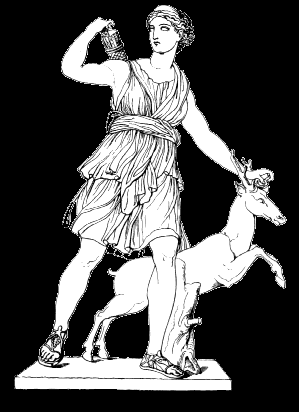

|
The Roman goddess of nature, fertility and childbirth. She is closely identified with the Greek goddess Artemis. Diana is also a moon-goddess and was originally worshipped on the mountain Tifata near Capua and in sacred forests (such as Aricia in Latium). Her priest lived in Aricia and if a man was able to kill him with a bough broken from a tree in this forest, he would become priest himself 1. Also torch-bearing processions were held in her honor here. Later she was given a temple in the working-class area on the Aventine Hill where she was mainly worshipped by the lower class (plebeians) and the slaves, of whom she was the patroness. Slaves could also ask for asylum in her temple. Her festival coincided with the idus (13th) of August Diana was originally a goddess of fertility and, just as Bona Dea, she was worshipped mainly by women as the giver of fertility and easy births. Under Greek influence she was equated with Artemis and assumed many of her aspects. Her name is possibly derived from 'diviana' ("the shining one"). She is portrayed as a huntress accompanied by a deer. Diana was also the goddess of the Latin commonwealth |
|
Diana, in Roman mythology, goddess of the moon and of the hunt. The Latin counterpart of the Greek virgin goddess Artemis, Diana was the guardian of springs and streams and the protector of wild animals. She was, in addition, especially revered by women, and was believed to grant an easy childbirth to her favorites. In art she is typically shown as a young hunter, often carrying bow and arrows. The most celebrated shrine to Diana was on Lake Nemi, near Aricia. Source; Encarta encyclopedia
|
|
Diana—Goddess of the wildwood, lady of beasts; Moon goddess. Goddess of mountains, woods, women, childbirth. Her title "Queen of Heaven" was the Roman name for the Triple Goddess; as the Roman Triple Goddess, her aspects were the Lunar Virgin, Mother of Creatures and the Huntress or Destroyer. Her festivals were May 26-31 and August 13 and 15. Her animals were the dog and stag Source; Conway, DJ. Magick of the Gods & Goddesses.
St. Paul, MN: Llewellyn Publications 191 |
|
Ceres and Diana. In their aspect of Italic divinities Ceres and Diana offer no particular interest. Ceres, who came from Campania, had a temple in Rome; but her rites, like the temple itself, were Greek. Diana retained only briefly her primitive character as a goddess of light, mountains and woods. She was rapidly hellenised. Among other sanctuaries Diana had a temple on the shores of Lake Nemi whose priest was traditionally an escaped slave. In order to obtain this office he had first to kill his predecessor in single combat. From then on he, too, was a target for any assassin who might wish to supplant him.
Source; Guirand, Felix, ed. THE LAROUSSE ENCYCLOPEDIA OF MYTHOLOGY.
Trans. Richard Aldrington and Delano Ames, New York. Barnes & Noble Books. 1994, 211 |
 |
 |
 |
 |
 |